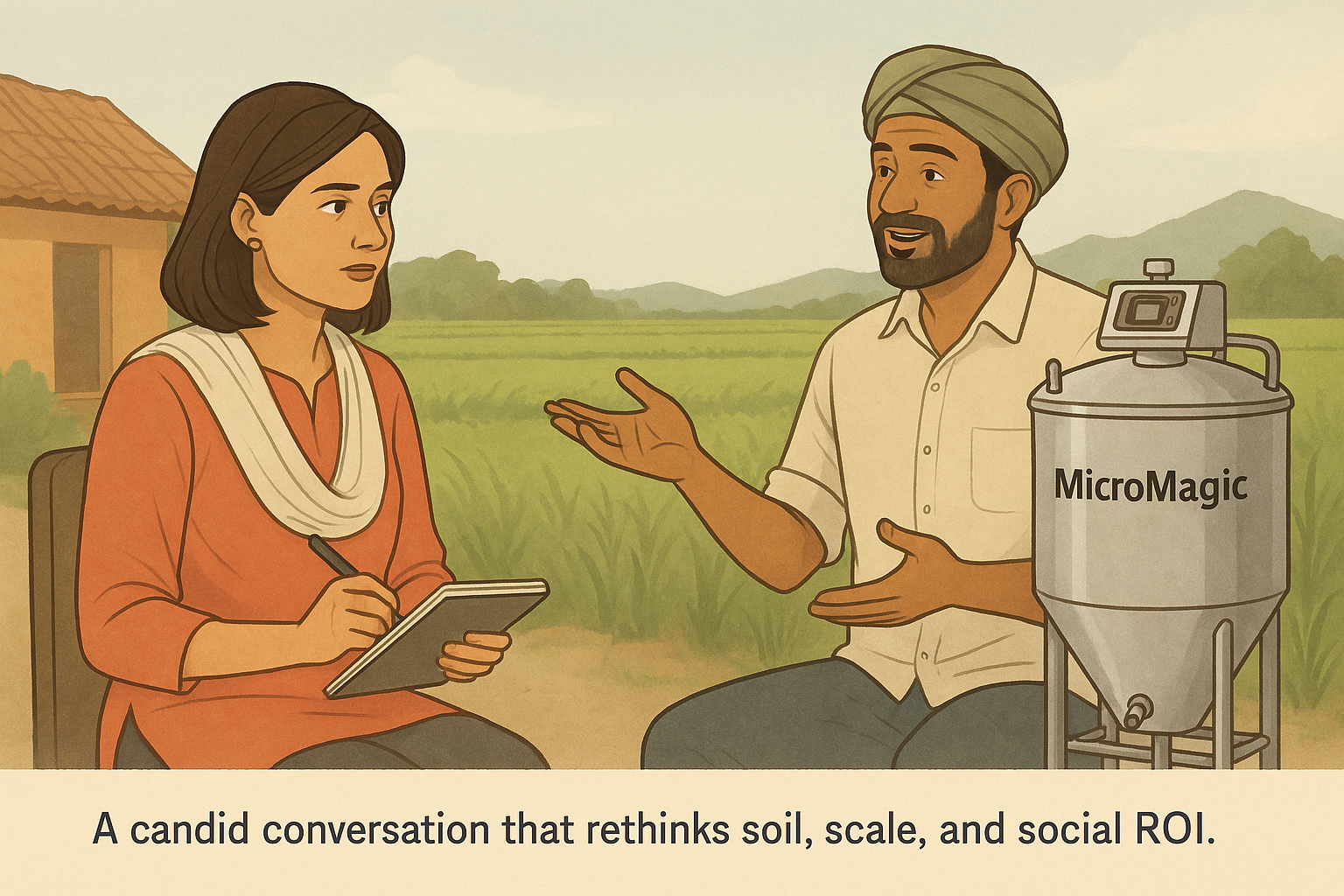
The teaser of Self Running Soil Revolution for an investment of Rs. 400/Acre was not easy to digest for Anitha, …. Being a friend she called up Vijay Dhole, CEO Mitrasena to explore. This blog capture the essence of that conversation. A candid chat evaluating the MicroMagic project from the eyes of a social impact fund.
Anita (Founder, GreenRoots Impact): “Senapati, on-farm fermentation is exciting—but can village entrepreneurs really pull this off without a mini-factory? Can they really maintain lab-grade quality?
Me (grinning): “If you can boil rice, you can run MicroMagic. It’s a standalone unit—no boilers, no compressors, no PhD-level tech. Runs on <1 kVA, 230 V power. Farmers load the seed + media kit from Mitrasena, follow simple SOPs, and voilà—quality microbes production happens every time.”
Anita (raising an eyebrow): “So for every batch you mean they will get the seed culture and nutrient media from your end. Will it not be expensive? Will that not make them dependent on you?”
Me: “Good question. Look at it from a different perspective. Producing good quality microbes every time needs a trained microbiologists plus a lab infrastructure. At micro level building that infrastructure and maintaining the skilled manpower will be an expensive proposition. So, we propose the system to help them maintain the quality as well as the cost. In fact we also support them with a QC for every batch, if they send the sample back to us. However, this support is not binding. Anyone with a lab knowledge can use his or her own culture and media. I shall cover the cost when we evaluate economics”.
Anita: “So you’re not dumping hardware; you’re embedding knowledge. I like that. But what about costs and revenue? Entrepreneurs need a clear revenue model. ”
Me: “Seed + media kit per batch costs under ₹25/L. They sell at ₹50–60/L locally. Do the math: even with modest volumes, they recover their investment in two cropping cycles—and earn a tidy margin on every litre.”
Anita (smiling): “So they’re micro-entrepreneurs, not just consumers.”
Me: “Exactly. You get sustainable livelihoods plus healthier soils. And once farmers taste the results—vibrant root systems, higher yields—they’ll clamour for more eco-inputs: bio-pesticides, IPM blends, next-gen bio-stimulants. Some of those they can brew locally, others they’ll still buy from specialist makers. You get a thriving, collaborative ecosystem. Everyone wins.”
Anita: “I love how this builds both livelihoods and soil health. It sounds like you’re democratizing access and building a market at the same time.”
Me (raising an eyebrow): “Democratize, yes—but not dilute quality. We’re fighting soil erosion, restoring carbon sinks, cutting CO₂. This isn’t charity; it’s urgent scale for impact. When pricing barriers drop, adoption rockets—just look at how affordable smartphones unleashed mobile banking in rural India.”
Anita (jotting notes): “Mobile banking parallels—that’s compelling. Impact plus ROI? But, what about uptake. How do you generate demand? What about the capital investment?
Me: “Perfect question. A single fermentor system costs about Rs. 2 Lakhs. Plus there has to be a 200 sft room to house it. Small working capital for cans & bottles may be required. Uptake needs some extension work and activities. Later great results makes it a flywheel running on its own. Rather thrive on its own. With all all these, a social support of about Rs 400/ Acre (Rs. 6 Lakhs for single project with 1500 Acres target area) can get it going. This covers the cost of equipment, initial support for field activities, demand generation etc. In fact in few clusters, there is already a subtle demand present. There the impact can be made with just Rs. 200/ Acre as well.”
Anita (nodding): “Rs. 400/Acre and a self running high impact engine sounds impressive. Impact plus ROI”
Me: “Spot on. Impact investors get both social returns—thousands of micro-enterprises, millions of healthier hectares. In fact the impact measurement can be on measuring changes in soil organic carbon, soil biology, reduction in pesticide usage and increase in farmer income. Solid impact pointers to monitor and measure. After all, we don’t consider is a grant, we like to call it social investment and it should have measurable return. And I think this project gives an excellent ROI.”
Anita : “Who will do the impact analysis?”
Me: “You can appoint any auditor to that.”
Anita: “Sounds great. How fast can you deliver the first machine for one of our existing clusters.”
Me: “3-4 Weeks by which time, we can get the site ready.”
Anita: “So let’s get started. Why delay”
Key Takeaway:
MicroMagic’s “stove-top” simplicity and sub-₹25/L production cost turn any cooking-savvy villager into a profitable bio-enterprise—igniting mass microbial adoption, building trust in eco-inputs, and powering a commercially vibrant, planet-positive ecosystem.
There was this interesting discussion I had with Mr Prateek
The effectiveness of any microbial product depends not just on
“Can I mix all microbes and spray together?” That’s like
Mitrasena (Army of friends) is global brand of Biowall Agrihealth Pvt Ltd. Mitrasena products & protocols enables seamless transition to non-toxic farming by concurrently offering Excellent Protection, Higher Productivity & Profit and, Ease of use.
We are a DIPP recognized Startup working for non-toxic crop protection. We are driven by a highly passionate and professionally competent team.
MitraSena © 2025 | All rights reserved | Innovatively Designed and Built by Social Mukul Media
Have any query about bulk orders? Get in touch with us.